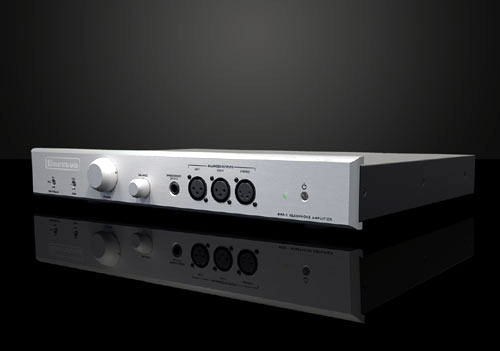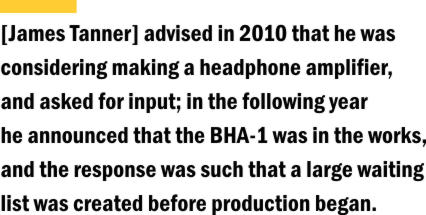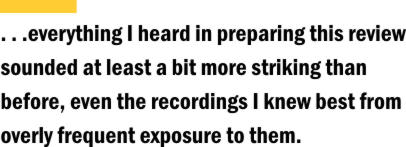Bryston • BHA-1 Headphone Amplifier
headphone amplifier is usually one of the last audio devices that comes to the attention of the citizen audiophile -- the music lover who takes enough interest in audio gear to build his own system. This listener may have the resources to duplicate the setups recording producers and engineers use for session playback, but he would not be as likely to go to Las Vegas for CES as to Vienna for a performance at the Staatsoper.
Even after bringing in an isolated circuit for the power amplifier(s), after installing acoustical panels on the walls and ceiling, and after placing shock-absorbing devices under a turntable or CD player, the audio layman who sometimes listens to music through headphones plugged into the jack on a preamplifier or CD player is likely to be surprised to discover the very existence of this particular phenomenon -- let alone what a headphone amplifier can add to his enjoyment of his chosen "cans" or in-ear monitors (IEMs), and in some instances affect his preferences among them. This situation, however, has been changing during the last decade or so, and, as with other audio devices, headphone amps now come from many of the established names in audio, at prices ranging from economical to out of sight. As usual, price alone is not a reliable indicator of performance, but some names are. Bryston is definitely one of them, and any announcement of a new product from this source creates attention and high expectations. There may be no element of surprise, then, in reporting that the new BHA-1 is a winner, but the level of satisfaction it delivers is something that can never be taken for granted, no matter what the source.
Originally, the BHA-1 was offered in two versions: one with its own internal power supply, the other for use with the MPS-2 external power supply introduced a few years earlier for use with the BP-26 preamplifier. Once actual production began, only a few of the units requiring an external power supply were sold; that option was abandoned, and new features were added to the original design. There were also some minor changes along the way. Originally, the BHA-1 was to have separate single-pin outputs for full-sized plugs (6.3mm) and minis (3.5mm), but this was modified to a single 6.3mm jack -- a sensible decision, since IEMs, which use the smaller plug, tend to have very short connecting cables, requiring an extension for use as part of a permanent indoor system, and that cable can be fitted with a 3.5mm input at one end and a 6.3mm connector at the other. The BHA-1 also has balanced outputs for headphones so designed, and it may be the least expensive headphone amp to offer this feature. The position of the one single-pin jack on the front panel was eventually moved from one side of the balanced outputs to the other. A more substantial change (and apparently the final one) was the addition of balanced outputs to the rear panel, to make the BHA-1 usable as a system preamplifier. Because units were being shipped even as the various modifications were being made, Bryston has been unable to keep its user’s manual up to date. As of March 2013, this issue remained to be addressed -- and nobody who was high enough on the waiting list to be using this product by then is likely to be at all distressed, for the BHA-1 is virtually self-explanatory when it comes to hooking it up and using it. The controls on the front certainly require no explication. A single toggle switch at the right end turns the unit on (confirmed by a green LED) or off. A toggle switch at the left end provides choice between a balanced and unbalanced source connection. Another such switch, next to it, is for choosing between high- and low-gain settings: a very useful option for listening to an LP played with a moving-coil pickup, or using low-efficiency ’phones. To the right of the large volume knob is a smaller one for balancing the two channels. The unbalanced headphone jack separates it from three XLR outputs for balanced headphones: a pair for the two separate channels, a single four-pin jack for stereo. On the back are the XLR and RCA input jacks, and the pair of balanced outputs. let the unit burn in for more than 100 hours before starting to make notes of any kind. Apart from its versatility, it simply did what one hopes an upgrade or addition of any kind might do: it strengthened an already good system and enabled good recordings to make their strongest impact. How it does this is a challenge to describe, but it was plain enough in listening to recordings I’ve used for years to test my system or evaluate various components. By way of further providing meaningful comparisons, the headphones I used with the BHA-1 were not pricey "boutique" models, but the inexpensive ones I’ve come to like during the last several years, as I began doing more of my listening this way, all of them solidly proven performers. In addition to two pairs of traditional over-the-ear models -- Sony’s MDR-7506 and Ultrasone’s PRO 750 -- I used four pairs of IEMs, by now my preferred format: the established benchmark Etymotic ER-4S, the terrific B&W C5, which I reviewed here in September 2011, and two models from Reid and Heath Acoustics (RHA) -- the MA 350 and the MA 450i -- just to hear what a truly inexpensive pair might be able to deliver. Both of these delivered plenty. I can report that the BHA-1 brought out the very best from all of these ’phones, reemphasizing and to a degree enhancing the qualities I had associated with them, and allowing the super-budget newcomers to make strong cases for themselves. The Ultrasones reached a tad further into the high end than what I had been accustomed to hearing from them (though still not a match for the freer, more assertive high range of the other ’phones in this respect), the MDR-7506 reminded me with renewed force why so many recording engineers rely on it, and the IEMs from both Etymotic and B&W seemed to reassert and subtly extend their familiar confidence and accuracy throughout the range. As for the two IEMs from RHA (which, having heard, I cannot dismiss as "cheapies"), the BHA-1 did not eliminate either of them by spotlighting flaws, but, as already indicated, empowered both to be strong contenders. The point is, this headphone amp is quite an enabler. I found, in listening with these various IEMs and "cans" to both LPs and CDs a somewhat fuller characterization of the various instrumental and vocal sounds -- not simply in terms of objectively measurable decibels or tonal extensions, but in identifying the defining "personality" of a piano, a bassoon, a trombone, a cello, a large organ, or a cluster of small percussion instruments, and a striking sense of what they are made of. If an otherwise attractive recording tended to be a rather dry, it now took on a somewhat warmer and more airy quality, without sacrificing anything in the way of detail or clarity. At the same time, recordings that tended to be too rounded-out took on a more agreeable focus and specificity, as certain boundaries which had barely made themselves felt to begin with were effortlessly extended, certain limitations gently lifted. Of the three CD players I used, the Bryston BCD-1 is my reference, and I especially enjoyed what I heard when I connected it directly into the balanced inputs of the BHA-1 instead of going through the system preamplifier. While I shouldn’t wish to exaggerate the difference this makes, it is an effective reminder that, other things being equal, the fewer the points of connection, the better the sound, and in this instance there was the added benefit of balanced connections over the RCAs for tape outputs on the preamp. No matter what recording I chose, or which headphones I chose to use, every one of these thrice-familiar recordings, and each of the headphones that had become favorites, simply sounded better than ever, while the newer ones were properly amazing. In Sir Adrian Boult’s recordings of Holst ("Dance of Spirits of Earth," from The Perfect Fool [Decca 444 549-2] and Elgar (Cockaigne Overture [First Hand Records FHR06]) -- certifiable sonic showpieces from the early years of stereo -- this meant that the brasses, from high trumpets to bass tuba, had a burnished-gold presence, enhanced equally in terms of both crispness and warmth, and with that reassuring hint of burr on the trombones in a certain range. It meant also that the pivotal ping of a briefly exposed glockenspiel in Beecham’s fiery yet suave account of the Polovtsian Dances, from Borodin’s Prince Igor [EMI 5 66998 2] shimmers in its full, silvery character, yet without undue prominence, comfortably cushioned in the basically warm sound at a pivotal moment just after a troublesome section of that otherwise marvelous recording. Overall, this sort of effect might be described as a matter of presence, in contradistinction to merely covering the tonal range. The phenomenal recording of the "Musique des automates," from the remarkable monophonic recording of excerpts from Delibes’s Coppélia, with Robert Irving conducting the Covent Garden orchestra [RCA Victor LM-2035], again was revivified by a sense of spaciousness and transparency that set forth an almost visible image of those tiny metallic instruments being struck and allowed their natural reverb and decay -- particularly with the IEMs, and cleanest of all with the two from RHA. While that monophonic "Musique des automates" continues to amaze and astound me in its monophonic realism, there are some only slightly later stereophonic recordings of both of the big Delibes ballets in their entirety which are downright dazzling stereophonic reproductions of full and detailed orchestral sound: a complete Sylvia, with Anatole Fistoulari conducting the London SO, and a complete Coppéia with Antal Doráti and the Minneapolis SO (as the Minnesota Orchestra was known in Doráti’s time on its podium), packaged together in a set of three CDs [Mercury 434 313-2]. These recordings are 55 years old (nearly as old as Robert Irving’s monophonic excerpts), but they are fantastically vivid and wide-open, and no allowance has to be made for their age. No superlatives would be an exaggeration here. The fanfares of the huntresses, near the beginning of Sylvia, were downright electrifying in their delineation of orchestral textures, as are all the brilliant instrumental effects in the "Procession of Bacchus" that opens Act III. In Coppélia, the Mazurka (not as part of the Prelude, but on its own, in this case Track 13 on Disc 2) was every bit as striking, with a bloom as well as burnish on the trombones and on the piquant yet properly discreet presence of tambourine and cymbals. Both of these super-virtuoso performances, in their revivified sound, were hair-raising and heart-warming at the same time, quite a reminder that some enduringly grand demo-quality recordings were made in the 1950s, after all. I don’t recall that either of these Delibes recordings was quite as impressive in its original LP incarnation as it became in Wilma Cozart Fine’s Living Presence CD reissue series, though, or that either has ever sounded quite as stunning as both did with the BHA-1.
Similarly happy impressions of old friends made more attractive and lovable than ever came from Fritz Reiner’s stunning performance of the Polka and Fugue from Weinberger’s Schwanda, a prime orchestral showpiece, taped with the Chicago SO in 1956 [RCA Victor 09026-62587-2], and from the jauntily imaginative setting Psalm 150 that concludes Giuseppe Sarti’s "Russian Oratorio," with its colorful orchestra, lusty chorus and assertive organ, performed by Czech forces under Václav Smetácek [Studio SM D2456]. Whether in such dramatic celebrations of orchestral color as the scherzo of Sir Granville Bantock’s Pagan Symphony (Vernon Handley conducting the Royal Philharmonic [Hyperion CDA66630]) or the deceptively simple intimacy of the variation movement of Mozart’s big Divertimento for string trio as performed by the Grumiaux Trio [Philips 454 023-2], the BHA-1, in sometimes small but always significant increments, got just that much more out of the familiar recordings, and out of the headphones themselves -- a little more spaciousness, a little more depth, an impression of a treble region without limits, and revelations of more than a few subtle details, such as the welcome conversion of the fiery edge on the violin in that Mozart recording to a more embracing kind of warmth in keeping with the nature of both this particular music and the instrument itself, a subtle infusion of solidity without loss of dramatic tension or detail. ubtlety, in fact, is one of the essential strengths
of the BHA-1, whose remarkable satisfaction level is achieved not by overturning basic
concepts of musical sound, but by living up to them. In this instance that means enabling
any headphone connected to it to live up to its own full potential. It shows the
recordings at their fullest and best, and overall provides the clarification and
vividness that enable the listener to be more fully and happily engaged with the music
than with the electronics involved in delivering it -- though very reassuringly aware of
the improvement this unit provides, at a price that has little relation to its value.
|
|||||||||||




 The addition of this
product to the Bryston line came about in large part in response to requests from
audiophiles/music lovers already using Bryston amps and preamps. James Tanner of Bryston
has always been responsive to -- and has in fact solicited -- requests and indications of
interest from Bryston loyalists in developing new products. He advised in 2010 that he was
considering making a headphone amplifier, and asked for input; in the following year he
announced that the BHA-1 was in the works, and the response was such that a large waiting
list was created before production began.
The addition of this
product to the Bryston line came about in large part in response to requests from
audiophiles/music lovers already using Bryston amps and preamps. James Tanner of Bryston
has always been responsive to -- and has in fact solicited -- requests and indications of
interest from Bryston loyalists in developing new products. He advised in 2010 that he was
considering making a headphone amplifier, and asked for input; in the following year he
announced that the BHA-1 was in the works, and the response was such that a large waiting
list was created before production began. But everything I heard in
preparing this review sounded at least a bit more striking than before, even the
recordings I knew best from overly frequent exposure to them. One of these was yet another
Delibes recording, made at about the same time as the two on Mercury: Ernest
Ansermet’s performance, not from his set of the complete score with his own Geneva
orchestra, but from a collection of ballet excerpts with the orchestra of London’s
Royal Opera House, Covent Garden, taped by Decca for release on RCA and eventually issued
in two or three different packagings on LP. I heard it on a beautiful 1964 pressing in
RCA’s short-lived Victrola budget series [RCA VICS-1066], which still demonstrates
how realistically and fully the details of orchestral sound can be preserved.
But everything I heard in
preparing this review sounded at least a bit more striking than before, even the
recordings I knew best from overly frequent exposure to them. One of these was yet another
Delibes recording, made at about the same time as the two on Mercury: Ernest
Ansermet’s performance, not from his set of the complete score with his own Geneva
orchestra, but from a collection of ballet excerpts with the orchestra of London’s
Royal Opera House, Covent Garden, taped by Decca for release on RCA and eventually issued
in two or three different packagings on LP. I heard it on a beautiful 1964 pressing in
RCA’s short-lived Victrola budget series [RCA VICS-1066], which still demonstrates
how realistically and fully the details of orchestral sound can be preserved.